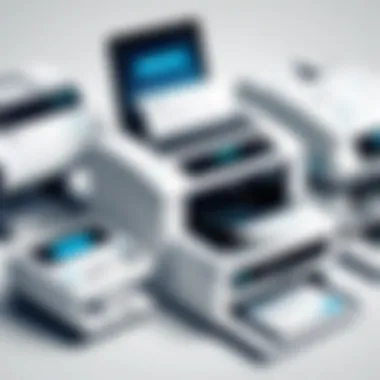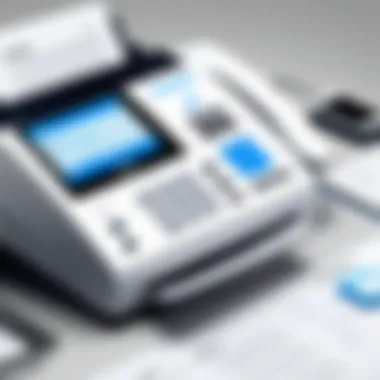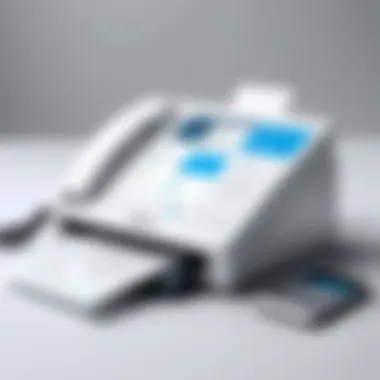Comprehensive Guide to Internet Fax Line Services


Intro
In our rapidly evolving digital landscape, communication is an essential cornerstone of business operations. One of the services transforming communication is the internet fax line service. This guide delves into the nuances of internet faxing, shedding light on its functionality and the significant benefits it offers over traditional fax methods. It focuses on the technology driving these services and compares cloud-based solutions with their older counterparts.
This exploration is tailored for IT professionals who seek to refine their communication protocols. As we unpack these concepts, we will address features to consider when selecting a provider, best practices for implementation, and tackle common misconceptions regarding internet faxing.
Hardware Overview
Specifications
To effectively use an internet fax line service, one must understand the hardware involved. While traditional fax machines required dedicated phone lines and physical paper, internet faxing redefines this necessity using a computer, an internet connection, and compatible software tools.
The hardware needed generally includes:
- Computer: A desktop or laptop serves as the primary device for sending and receiving faxes. Ideally, it should run on a modern operating system for optimal use.
- Scanner: Though not always necessary, a scanner enhances functionality by enabling the conversion of physical documents into digital formats.
- Internet Connection: A stable and fast connection is crucial. The quality of your service can be affected by bandwidth limitations.
Performance Metrics
Performance metrics are critical when evaluating internet fax line services. Key performance indicators typically include the following:
- Speed: The time taken from sending a fax to successful delivery should be minimal.
- Reliability: Consistent service with downtime scheduled for maintenance is preferred.
- Security: Data encryption protocols must be in place to protect sensitive information.
"Reliable and secure delivery of documents can significantly enhance operational efficiency as business rely on fast communication."
Software Analysis
Features and Functionality
The software underpinning internet fax line services can determine user experience and capability. Different services offer varying features, some of which are essential for effective communication:
- Integration: Seamless integration with existing applications like emails boosts productivity.
- Document Management: Many services include features for tracking, storing, and categorizing documents for easy retrieval.
- Cost-Effectiveness: Software that minimizes costs associated with sending faxes is vital for budget-conscious organizations.
User Interface and Experience
A well-designed user interface can simplify the faxing process. Interfaces should be intuitive, allowing users to easily:
- Upload files
- Input recipient information
- Monitor fax status (sent, received, or failed)
An effective user experience leads to higher adoption rates within organizations.
Determining an optimal internet fax line service requires a balance of hardware and software considerations tailored to the specific needs of an organization. A deeper understanding of these elements fosters more efficient communication, elevating overall productivity and performance.
Understanding Internet Fax Line Services
Understanding Internet fax line services is crucial in today’s digital era. As traditional fax machines slowly fade from relevance, businesses require efficient and cost-effective solutions for document transmission. Internet faxing, or online faxing, fills this gap by leveraging internet connectivity. This ensures that faxing is no more constrained by physical limitations, such as reliance on phone lines.
In an environment where communication speed and security are paramount, Internet fax services present numerous benefits. They allow for the easy sending and receiving of documents without the need for dedicated machinery. This can lead to increased productivity and streamlined workflows.
One of the key considerations when using internet faxing includes understanding the service’s reliability and security features. Many services use encryption to protect sensitive documents during transmission, ensuring that data breaches remain minimal. Additionally, users can benefit from features like digital signatures and comprehensive logging of sent and received faxes.
Defining Internet Faxing
Internet faxing is the process of sending and receiving facsimiles over the internet rather than through traditional telephone lines. This method of communication converts documents into digital data, which is then transmitted via email or directly through a user-friendly web interface. Essentially, it combines the functionality of fax machines with the versatility of email technology.
Businesses increasingly favor internet faxing due to its convenience. Users can send faxes from any device with internet access, such as computers, tablets, and smartphones. This flexibility allows for immediate communication without needing to be physically present at a fax machine. It also reduces the need for paper, ink, and maintenance associated with traditional fax machines, aligning with the modern shift toward greener practices.
How Internet Fax Services Work
The operation of internet fax services hinges on a straightforward process. Initially, a user prepares a document, typically in PDF or another supported format. Once the document is ready, the user accesses the internet fax service, uploads the file, and inputs the recipient's fax number.


Upon submission, the service converts the document into a format suitable for fax transmission. This conversion process can occur within seconds. Once the document is ready, the service establishes a connection to the recipient’s fax machine through the internet, ultimately delivering the fax as if it were sent through traditional means.
Several key features enhance the efficiency of internet fax services:
- Cloud Storage: Most providers offer cloud storage options for easy access to sent and received documents.
- Email Integration: Users can receive faxes directly to their email, making it simpler to manage communications.
- Security: Encryption and authentication features protect sensitive data throughout the transmission process.
Ultimately, understanding these dynamics allows IT professionals and businesses to effectively adapt and integrate internet fax services into their communication strategies.
Comparing Traditional and Internet Fax Systems
Understanding the distinctions between traditional and Internet fax systems is essential for any organization looking to modernize its communication infrastructure. Traditional fax machines often come with limitations that hinder efficiency and flexibility in today’s fast-paced digital environment. On the other hand, Internet fax services offer an array of advantages that can significantly enhance communication protocols. We will delve into the constraints of traditional fax machines, the benefits of embracing Internet fax services, and the associated cost implications.
Limitations of Traditional Fax Machines
Traditional fax machines have served a critical role in business communication for decades. However, they have several limitations that can impede operational efficiency.
- Paper Dependency: Traditional fax machines rely on physical paper, which not only adds to costs but also can lead to clutter in an office setting. This dependency creates challenges related to document management.
- Limited Accessibility: Accessing a traditional fax machine is not always convenient. Users often need to be physically present to send or receive a fax. This limitation is a stark contrast to cloud-based solutions that provide accessibility from virtually anywhere with internet connectivity.
- Slower Transmission Speeds: The speed of sending a fax through a traditional machine can be subpar, especially when considering the size of documents. Waiting for a multi-page fax can result in significant delays in urgent situations.
- Maintenance Issues: Traditional machines require regular maintenance, such as replacing cartridges and troubleshooting technical issues. This not only incurs additional costs but also detracts from productivity.
In summary, these limitations often make traditional fax machines less appealing compared to more modern solutions.
Advantages of Internet Fax Services
Embracing Internet fax services can address many of the issues associated with traditional fax machines while offering various advantages:
- Enhanced Accessibility: Internet fax services allow users to send and receive faxes from any device connected to the Internet. This includes computers, tablets, and smartphones, which enhances flexibility and productivity.
- Cost-Effectiveness: By reducing reliance on paper and physical machines, businesses can save on printing and supplies. Additionally, many online services offer subscription models that can be more cost-effective than maintaining a traditional fax machine.
- Faster Processing Times: Internet fax services typically offer quicker transmission speeds, allowing users to send large documents almost instantly. This can be crucial in time-sensitive situations.
- Integrated Features: Many Internet fax services come equipped with additional features like document storage, electronic signatures, and direct email integration. These capabilities allow for a more streamlined workflow.
Overall, the advantages of Internet fax services position them as a superior choice for modern businesses.
Cost Implications
When comparing the cost implications of using traditional fax machines versus Internet fax services, several factors should be considered:
- Initial Investment: Traditional fax machines require upfront purchases that can be expensive, especially for high-capacity models.
- Operational Costs: The ongoing costs of paper, ink, and maintenance for traditional machines can add up significantly over time.
- Flexibility in Pricing: Internet fax services typically offer a range of pricing options, allowing businesses to select a plan that fits their specific needs. This flexibility can lead to better budget management.
- Cost of Downtime: If traditional machines malfunction, businesses may experience downtime that can negatively impact productivity and costs. In contrast, Internet fax services typically offer more reliable uptime metrics, minimizing potential losses.
"Choosing between traditional and Internet fax systems can profoundly influence a company's communication efficiency and costs."
By examining these factors closely, organizations can make informed decisions that align with their operational needs and budget constraints.
Key Features of Internet Fax Services
Internet fax services offer several features that significantly enhance the way businesses communicate. Understanding these features is crucial when selecting an appropriate service. These elements can impact efficiency, security, and overall functionality in a business setting. Here, we will explore key features such as email integration, document security, fax-to-email functionality, and mobile access. These features not only distinguish internet faxing from traditional methods but also offer tangible benefits to users.
Email Integration
Email integration is essential for modern communication. It allows users to send and receive faxes directly through their email accounts. This functionality eliminates the need for separate fax machines, reducing hardware costs and maintenance efforts. Users can simply compose an email, attach the document intended for faxing, and send it to the designated fax number. This streamlines workflow and enables quick handling of documents. Moreover, users can keep a complete digital record of their communications, enhancing organization in document management.
Document Security
Security is a paramount concern for any organization. Internet fax services prioritize this aspect by utilizing encryption protocols. This ensures that sensitive information remains confidential during transmission. Unlike traditional fax machines, which can be accessed by unauthorized personnel, internet fax services often require authentication measures. Users can set access controls and define who can send or receive faxes, adding an additional layer of security. Such measures are vital in industries that handle sensitive data, such as legal and healthcare sectors.
Fax-to-Email Functionality
Fax-to-email functionality transforms incoming faxes into email attachments. This feature simplifies the user experience. Instead of dealing with physical paper copies, users receive a digital version of the fax in their inbox. This capability allows for swift responses and easier sharing of documents. Furthermore, it minimizes paper usage, contributing to environmentally friendly practices. Users benefit from organizing their electronic correspondence more efficiently, which can be crucial in fast-paced work environments.
Mobile Access
Mobile access is another significant feature of internet fax services. In today's fast-moving world, the ability to manage communications on-the-go is essential. Many internet fax services offer mobile applications that permit users to send and receive faxes from their smartphones or tablets. This flexibility supports remote work and enhances productivity. Users can access their fax accounts anytime and anywhere, ensuring important documents are not delayed.
Selecting an Internet Fax Service Provider
Choosing the right internet fax service provider is crucial for any organization looking to enhance its communication capabilities. With numerous options available, the selection process can be complex. Understanding the nuances of each provider allows IT professionals to determine which service best fits their needs.


Factors such as reliability, pricing structures, and customer support play a pivotal role in this decision-making process.
Evaluating Service Reliability
Reliability is a cornerstone of internet fax services. When evaluating providers, it is essential to assess their service uptime and performance history. A reliable service ensures that faxes are sent and received without interruption. This reliability can be evaluated through:
- User Reviews: Analyzing customer feedback can reveal the overall satisfaction and service dependability.
- Service Level Agreements (SLAs): These agreements outline the expected performance and uptime guarantees. Look for providers that commit to at least 99% uptime.
- Redundancy Protocols: Understanding how providers handle outages and whether they have backup systems in place can be important. A provider with robust redundancy is likely to offer better service continuity.
Ultimately, selecting a provider with proven reliability will minimize disruptions to your business activities.
Pricing Structures
Cost considerations are paramount when selecting an internet fax provider. Pricing structures can vary significantly between providers and come in various forms:
- Subscription Models: Most providers offer tiered subscription plans based on the volume of faxes sent or received. It’s important to choose a plan that aligns with your operational needs.
- Pay-As-You-Go Options: For businesses with sporadic faxing needs, pay-as-you-go can be beneficial. This model charges based on actual usage without locking you into a long-term contract.
- Hidden Fees: Scrutinize the fine print for additional charges, such as extra fees for international faxes or overage charges if you exceed your plan’s limits.
Balancing quality of service with cost is fundamental for ensuring long-term value from your chosen fax service.
Customer Support Considerations
The quality of customer support cannot be overlooked. As businesses increasingly rely on digital solutions, problems can arise that may require swift resolution. Key areas to consider include:
- Availability: Check the support hours. 24/7 support can greatly benefit organizations that operate outside standard business hours.
- Support Channels: Look for providers offering multiple channels for support, including email, phone, and live chat. This flexibility can ease communication during emergencies.
- Technical Expertise: A knowledgeable support team can help resolve complex issues faster. Research providers' reputations for technical support and their response times.
In sum, thorough consideration of these elements will guide professionals in selecting an internet fax service provider that meets both current and future communication needs.
Implementation of Internet Fax Services
Implementing an internet fax service is a crucial step for any organization aiming to enhance their communication processes. This section delves into the various aspects that shape a successful implementation. Understanding these elements can greatly benefit IT professionals and tech enthusiasts seeking to adopt modern, efficient faxing technologies.
The significance of implementing internet fax services lies in streamlining operational workflows. These services facilitate a more efficient document transmission process and provide a secure alternative to traditional faxing methods. Moreover, they often come with features that enhance overall productivity, allowing users to send and receive faxes directly from their email accounts or mobile devices. This flexibility stands in stark contrast to the limitations of conventional fax machines which require physical presence and dedicated lines.
When considering implementation, organizations should assess several factors, including the software chosen, required hardware, and the alignment with existing communication protocols. By carefully planning the implementation process, organizations can avoid potential pitfalls and ensure a seamless transition.
Initial Setup Steps
The initial setup steps for an internet fax service are typically straightforward. First, it is essential to choose a reliable service provider that meets specific organizational needs. Factors such as features, compliance with regulations, and cost-effectiveness should be evaluated.
Once a provider is selected, the following steps are generally recommended:
- Create an Account: Register with the chosen provider to obtain necessary credentials.
- Choose a Fax Number: Assign a dedicated fax number or utilize an existing one, depending on the service.
- Configure Settings: Adjust the configuration settings to align with the organization’s requirements. This involves setting preferences for notifications, document formats, and user permissions.
- Test Functionality: Perform test faxes to ensure that sending and receiving work correctly. This step is crucial for avoiding issues when operations go live.
- Train Users: Provide training sessions for employees to familiarize them with the new system and ensure they understand its features and benefits.
Establishing a solid foundation during these initial steps is vital for maximizing the advantages of internet faxing.
Integration with Existing Systems
Integration with existing systems is a critical aspect of the implementation journey. Organizations often possess numerous tools and software that enhance overall communication and productivity. Therefore, the ability of the chosen fax service to integrate seamlessly with these systems can determine the success of the transition.
Main integration points to consider include:
- Email Systems: Most internet fax services allow users to send faxes via email. It is important to ensure compatibility with existing email platforms such as Microsoft Outlook or Gmail.
- Document Management Systems: Integration with systems like SharePoint or Google Drive can facilitate easy access to documents. This approach minimizes the hassle of searching for files to fax.
- CRM Software: If the organization utilizes customer relationship management tools, linking fax services can streamline communication efforts with clients.
Ensuring that the internet fax service works fluidly with these systems will enhance workflow efficiency. Ultimately, a well-planned integration fosters better communication channels, supporting the broader organizational goals.
Common Misconceptions About Internet Faxing
The understanding and implementation of Internet fax services are often clouded by various misconceptions. This section aims to clarify these misunderstandings, emphasizing their relevance for IT professionals and tech enthusiasts considering the integration of such services into their communication processes. By debunking myths surrounding security and quality, it can enhance confidence in adopting internet fax as a robust solution.
Debunking Security Myths


One prevalent myth is that Internet faxing is considerably less secure than traditional faxing. Many people assume that because internet faxing relies on digital technology, it exposes data to potential cyber threats. However, this belief fails to recognize the advancements in encryption technology and secure data transmission.
In contrast to traditional faxes that transmit unencrypted documents over phone lines, Internet fax services often utilize secure protocols such as HTTPS. This means data is encrypted during transmission, making interception by unauthorized users far more difficult. Additionally, reputable services provide secure storage options, ensuring sensitive documents remain protected. Organizations can implement further security measures, such as multi-factor authentication and access controls, enhancing their document security.
"Adopting internet fax does not mean sacrificing security; it involves upgrading it to modern standards."
The understanding of security levels in internet faxing is crucial for companies worried about their data privacy. Integrating internet fax solutions with existing data protection policies can create a coherent approach to safeguarding information.
Addressing Quality Concerns
Another misconception is that Internet faxing leads to inferior quality results compared to traditional methods. Critics argue that electronic transmissions suffer from resolution losses, causing important details to be compromised. This claim often arises from outdated perceptions of internet fax technology.
Modern Internet fax services utilize high-resolution scanning methods and advanced compression algorithms to ensure high-quality document transmission. Unlike traditional fax machines that may produce poor-quality copies when scanning images or fonts with intricate details, modern internet solutions maintain fidelity.
Moreover, users can preview documents before sending them, allowing for quality assurance. The technology underlying these services ensures that faxes arrive clearly and accurately on the recipient's end.
In situations where quality is paramount, organizations can select providers that guarantee high-definition transmissions. Emphasizing quality assurance in the selection of Internet fax services can address any lingering doubts.
By breaking down these misconceptions, organizations can more confidently consider integrating Internet fax solutions into their operations, recognizing the real benefits they offer compared to traditional methods.
Best Practices for Using Internet Fax Services
Utilizing internet fax services efficiently requires an understanding of best practices. These practices are critical for ensuring effective and secure communication within organizations. In a world transitioning rapidly toward digital solutions, following these guidelines can significantly enhance the effectiveness of fax communication.
Ensuring Document Compliance
Ensuring document compliance is an essential aspect of using internet fax services. Legal and regulatory requirements often govern the communication and storage of sensitive information. IT professionals must ensure that all documents sent and received comply with relevant laws such as HIPAA, GDPR, or others depending on geographical jurisdiction.
To achieve compliance:
- Utilize encryption for sensitive documents. This reduces the risk of unauthorized access during transmission.
- Implement audit trails to track document activity. Knowing who accessed or modified a document is helpful for accountability.
- Regularly update business policies regarding document handling and ensure all staff are trained on these protocols.
Compliance maintains the integrity of communications and mitigates legal risks, positioning the organization favorably in audits or investigations.
Regular Maintenance and Updates
Maintaining and updating your internet fax service is a fundamental practice. Regular maintenance helps in identifying and correcting potential issues before they affect operations. Furthermore, updates bring new features and security enhancements that are vital for adapting to evolving technology and threats.
Key strategies include:
- Schedule routine checks on all software and hardware involved in faxing.
- Activate automatic updates for your internet fax service. This keeps your system secure against known vulnerabilities.
- Educate staff on changes and improvements in the fax service. This ensures everyone is aware of new features that can improve usability.
Keeping your internet fax system updated not only enhances reliability but also improves performance, ensuring that your organization stays ahead in operational efficiency.
Staying proactive in maintenance can save time and costs associated with potential faxing issues down the road.
Future of Internet Fax Services
The landscape of communication is constantly evolving, and the future of internet fax services is no exception. Staying abreast of these changes is critical for IT professionals and organizations looking to leverage technology to enhance their communication processes. Internet faxing continues to be integrated with advancements in secure transmission, cloud computing, and artificial intelligence, which provide improved efficiencies and capabilities.
Technological Advancements
The pivotal role of technological advancements cannot be overstated. As organizations migrate to digital workflows, fax services are adapting accordingly. Improved algorithms and increased bandwidth are making it possible to transmit documents faster.
Moreover, the integration of artificial intelligence is transforming many aspects of internet faxing. For instance, AI can automate the sorting and routing of faxes, a significant time saver for busy office environments. Additionally, machine learning algorithms help in enhancing document recognition and reducing errors.
Cloud technology has also revolutionized the storage and retrieval of faxed documents. Organizations can access faxes from various devices, contributing to a more seamless workflow. With enhanced data encryption methods and strict compliance with data protection regulations, the security of transmitted documents is greatly improved. This gives companies the confidence they need to utilize internet fax services without the fear of data breaches.
Market Trends
Market trends indicate that businesses are increasingly prioritizing flexible and scalable solutions. The demand for internet fax services is growing, particularly among remote workers and mobile professionals. Companies appreciate the flexibility of sending and receiving faxes from anywhere with an internet connection.
Additionally, the shift toward environmentally friendly practices has prompted businesses to adopt paperless solutions. This trend is in line with the growing emphasis on sustainability, reducing the environmental footprint associated with traditional fax machines.
"Companies are looking not just for automation but for comprehensive solutions that integrate seamlessly with existing tech stacks."
Particularly in regulated industries like healthcare and finance, the demand for reliable and secure internet fax services continues to rise. As organizations prioritize higher data privacy standards, they are more likely to invest in internet fax solutions that offer robust security features. This focus on data protection is a critical consideration for providers aiming to stay relevant in a competitive market.



